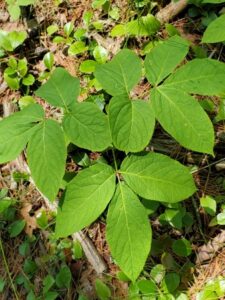July 7: Poison Ivy Proverbs

Poison ivy has compound leaves with three leaflets that are slightly shiny.
Is this poison ivy? It’s a question I often hear from folks when I am leading nature hikes on our preserves. More often than not the plant they are pointing at is not poison ivy, but something that does look similar. While on a walk recently, I noticed two native plants that are often confused with poison ivy growing next to the infamous plant. I took some pictures and thought I would share some identification tricks, so that next time you are out in the woods you might be better able to pick out the plant that might give you an itchy rash and the plants that won’t.

Dewberry has thorns on the stem, something poison ivy never has.
Most of us have heard of the saying “Leaves of three, let it be” to help identify poison ivy, but have you heard “If its hairy, it’s a berry”? Someone added on this catchy phrase to the old adage because berry plants are often confused with poison ivy. We have several species of berries in the Rubus genus growing on our preserves such as dewberry, blackberry, and raspberry, and they often have leaves growing in threes, meaning three leaflets make up one leaf. What sets them apart from poison ivy however is that when you look closely at the stems, berry plants are covered in tiny little hairs or thorns for protection.
Another addition to the poison ivy proverb is somewhat embarrassing to share, but I will do so for the sake of saving someone’s behind. “If its shiny, watch your heinie”. When poison ivy leaves first emerge in the spring, they appear shiny, glistening with the oil that gives some people a rash. The shiny factor in addition to similar compound leaves causes some confusion between poison ivy and the emerging leaves of wild sarsaparilla. You can identify wild sarsaparilla by looking closely at the compound leaves, as more often than not, they will be made up of 5 leaflets instead of 3 leaflets like poison ivy. Wild sarsaparilla also grows on a single long stalk with three branches of compound leaves, unlike poison ivy that grows as a ground cover, shrub, or vine.

Wild Sarsaparilla typically has five leaflets, but sometimes has three.
So next time you are out and the woods you and you see a suspicious plant, remember to walk yourself through “Leaves of three, let it be. If its hairy, it’s a berry. If its shiny, watch your heinie” and you will be one step closer to making a positive identification. But know that these are just guidelines and not hard rules because poison ivy like to plays the trickster and doesn’t always look the same. The leaves on one poison ivy plant may be toothed along the edges and smooth on another. When growing as a vine, poison ivy roots look hairy where it grasps the tree (although it has no thorns like berries). It can be shiny or not. So perhaps I will end by adding on my own line to the poison ivy proverb. “If it’s all too much, just don’t touch”.





